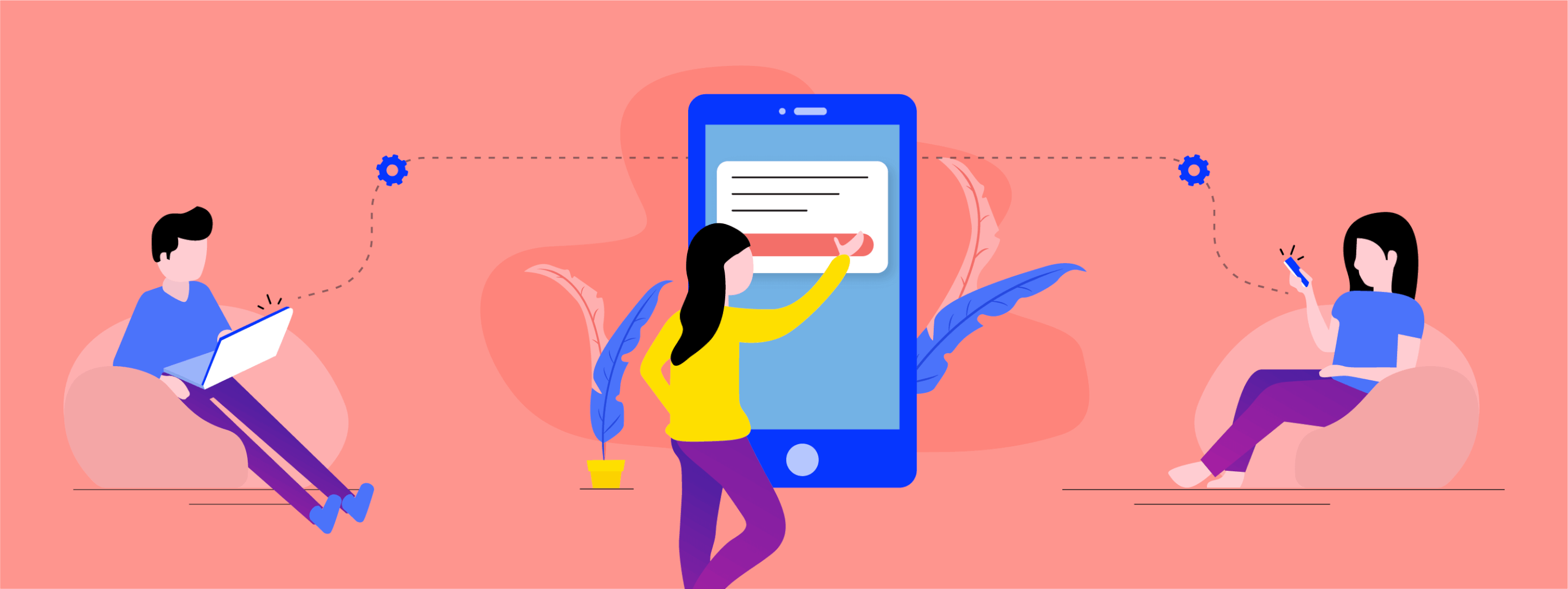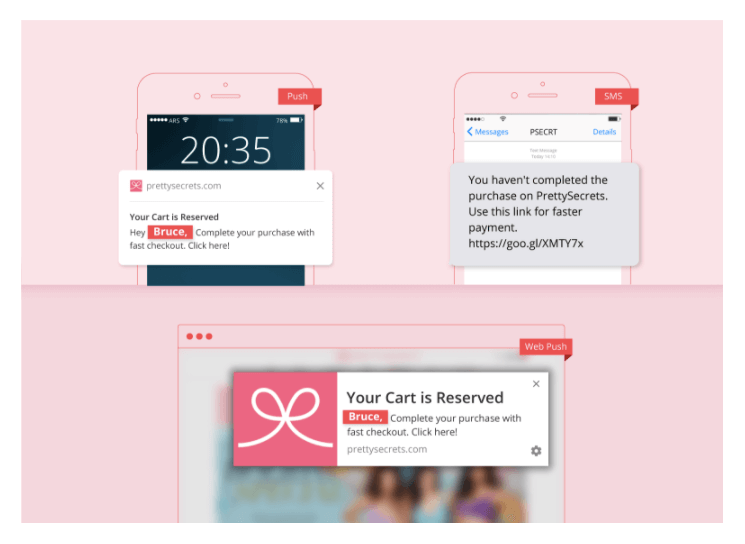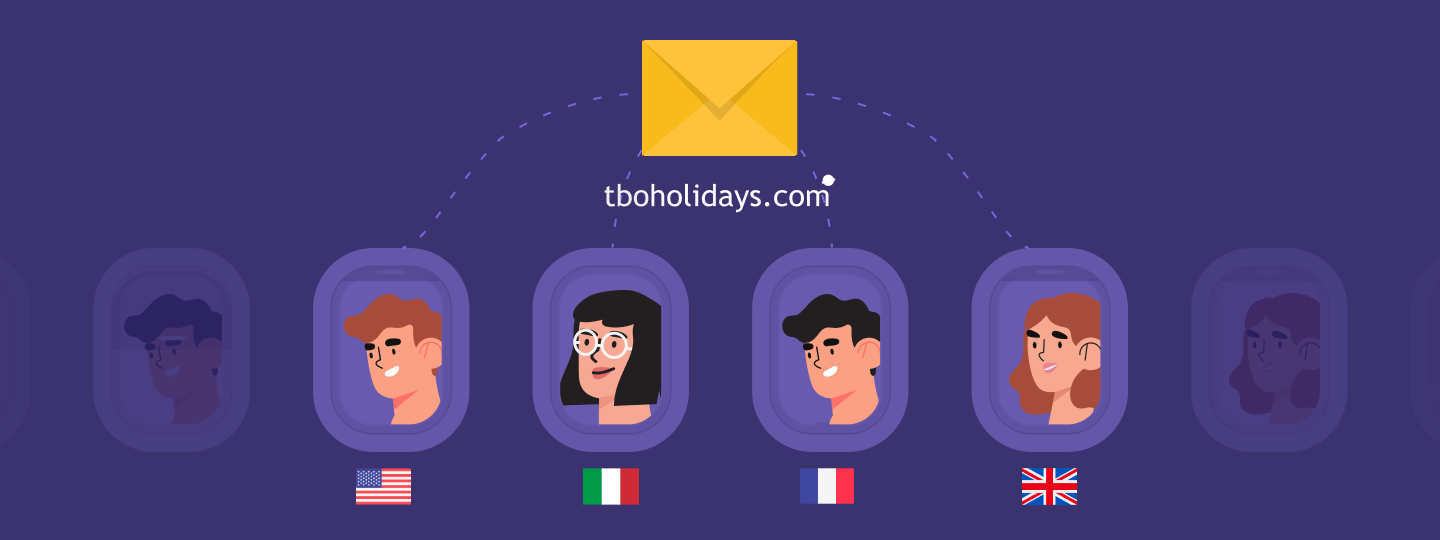What is B2C marketing automation?
A B2C marketing automation platform is a messaging software that lets you create, manage, and automate campaigns across the users’ lifecycle. You can create multi-channel campaigns to engage and retain your users based on the rules you define.
Every campaign can have a different objective, but the common goal is to keep the existing users engaged. With B2C marketing automation, you can also build and maintain unified customer profiles, analyze user engagement with your app/website, and make data-driven decisions that help you drive business growth and maximize revenue. According to a Sales Fusion survey, using marketing automation tools helped companies boost sales productivity by 14.5%, generate more leads, and lower marketing costs.
Statistically speaking, marketing automation makes a strong point for itself:
- 91% of marketers surveyed by Instapage say that marketing automation workflow is very important to the success of their marketing campaigns.
- Protocol80 says that the use of lead nurturing through marketing automation saw 15-20% of potential buyers that were not ready to purchase converted to sales.
Why is marketing automation important for your B2C business?
Every 9 in 10 marketers state that marketing automation is effective in helping them reach their goals.
But why?
If you are at the helm of a consumer business, then you NEED to be where your customers are.
- B2C Marketing Automation will give you the ability to engage with your customers contextually on a highly personalized level.
- You will have access to tons of user data that will help you create an intimate profile about your customers based on their demographic and behavioral data.
- You can facilitate one-on-one communication with your customers with not just personalized but hyper-personalized and highly relevant content.
Subscribe to our newsletter to stay updated on the latest in B2C marketing
B2B vs. B2C marketing automation: What’s the difference?
While marketing automation is a powerful tool for both B2B and B2C businesses, there are significant differences in how it’s applied in each context. Understanding these distinctions is crucial for creating effective automation strategies tailored to your specific audience and goals.
Buyer journey complexity and sales cycle length
One of the most significant differences between marketing automation for B2C and B2B lies in the complexity of the buyer journey and the length of the sales cycle.
In B2B, the buyer journey is often longer and more intricate, involving multiple decision-makers and stakeholders. The sales cycle can span weeks, months, or even years. B2B marketing automation focuses on lead nurturing, providing educational content, and building relationships over time to guide prospects through the sales funnel.
For example, a SaaS company might use automation to send a series of informative emails, case studies, and product updates to a prospect after they attend a webinar, eventually inviting them to a personalized demo.
In contrast, B2C buyer journeys are typically shorter and more straightforward, with purchasing decisions made by individual consumers in a matter of days, hours, or even minutes. B2C marketing automation aims to trigger immediate action, such as making a purchase or signing up for a service, often leveraging emotions and impulse buys.
A fashion retailer, for instance, might automate an abandoned cart email with a limited-time discount code to tap into the customer’s fear of missing out and encourage them to complete their purchase.
Personalization, segmentation, and data
While personalization is important in both B2B and B2C, the approach and data used can differ.
B2B personalization often relies on firmographic data (e.g., industry, company size, role) and behavioral data (e.g., content downloads, webinar attendance) to create targeted segments and messaging. B2B marketers often integrate their marketing automation system with their CRM to leverage data on previous interactions, backgrounds, and titles.
An IT solutions provider, for example, might segment their audience by industry and decision-maker role to deliver thought leadership content, product updates, and industry news.
B2C personalization, on the other hand, tends to focus on individual preferences and interests, leveraging demographic, psychographic, and behavioral data. B2C marketers often rely on social media, third-party data, and interactive elements like polls and games to gather insights and create highly relevant, personalized experiences.
A beauty brand, for instance, might use past purchase data and quiz responses to recommend products tailored to the customer’s unique skin type and concerns.
Engagement channels and focus
The channels and focus of engagement can also vary between B2B and B2C marketing automation.
In B2B, email tends to be the primary channel, supplemented by targeted ads, webinars, events, and account-based marketing tactics. The focus is on building relationships, providing value, and nurturing leads at the account level.
In B2C, while email is still important, there’s a greater emphasis on multi-channel automation across social media, push notifications, SMS, and more. B2C marketers often leverage a wider range of channels, including TV, radio, and billboards, to reach larger and more varied audiences. The focus is on individual customer retention, retargeting, and driving immediate action.
For example, a consumer electronics brand might automate a series of email, SMS, and social media messages to promote a flash sale and create a sense of urgency while also retargeting customers with personalized product recommendations based on their browsing history.
Metrics and Goals
Finally, while revenue is the ultimate goal for both B2B and B2C marketing automation, the specific metrics and KPIs tracked can differ.
B2B marketers often focus on lead generation, qualification, and conversion metrics, such as form fills, lead scores, sales qualified leads (SQLs), and account lifetime value. The goal is to drive revenue through high-value contracts and long-term relationships.
B2C marketers, in contrast, typically prioritize metrics like email open rates, click-through rates, conversion rates, shopping cart abandonment rates, and customer lifetime value. The goal is to maximize immediate sales while fostering brand loyalty and repeat business.
This brings us to the all-important question: How to leverage Marketing Automation technology to improve your brand’s marketing effectiveness?
To answer that, we have highlighted 15 examples to help you understand how different brands are using Marketing Automation:
15 B2C Marketing Automation Examples
- Welcome campaign
- Onboarding campaign
- Repeat purchase campaign (Customer Retention)
- Re-engagement/Reactivation campaign
- Multi-channel campaign
- Behavioral campaign
- Cross-selling campaign
- Information/update campaign
- A/B testing for campaigns
- Feedback campaign
- Upsell campaign
- Milestone campaign
- Referral campaign
- Location-based campaign
- Limited time campaign
1. Welcome campaign
Brand Examples: Resume.com, Airbnb, Tripoto
Communication medium used: Email
Industry fit: SaaS, E-Commerce, Travel
Having a Welcome campaign is perhaps the most obvious use of Marketing Automation. It is absolutely necessary for most brands to establish a connection right off the bat. You also can’t be bothered to shoot an email to every new signup, especially if you have a lot of users.
This is where automation shines and allows you to automate new sign-up emails right after registration.
Resume.com: Email example

Airbnb: Email Example

Tripoto: Email example

2. Onboarding campaign
Brand Examples: Tailor Brands, Mailchimp
Communication medium used: Email
Industry fit: SaaS, Online Marketplace, BFSI
Most apps lose about 77% of their DAU (daily active users) in the initial 3 days after install. Users often drop out early because of having very little understanding of using a new product. This is why it is crucial for businesses to have a sound onboarding process.
An onboarding campaign can help ease the user into the product step by step, and facilitate the transition from casual onlooker to invested active user.
Tailor Brands: Email example

MailChimp: Email example

3. Repeat purchase campaign – Customer retention
Brand Examples: Pinkberry, Flaberry, H&M
Communication medium used: Email, Push Notification
Industry fit: SaaS, E-Commerce, Travel
How do you extract more out of an existing customer? According to Adobe’s recent study, existing customers are responsible for creating 40% of revenue for an ECommerce store. Acquiring a new customer will be 5 times more expensive than getting a conversion from an existing one. However, increasing customer retention rate in the e-commerce industry by 5% can increase your profitability from 25% to 95%!
Your existing customers are familiar with your brand and your product, which makes them theoretically easier to convert compared to new customers.
Based on certain triggers derived from user behavior, you can create tailored campaigns with an incentive that will drive up the perceived value of the offer.
Pinkberry: Email example

Flaberry: Email example

- If you look at the Flaberry email closely, they have mentioned my cousins (Sona & Isha) being their customers. I had mentioned their names while personalizing their gifts during my last purchase.
- The second bit of personalization comes with the discount coupon code: PRIY10. It contains the first 4 letters of my name giving it the appearance of a one-off individual offer meant only for me.
H&M: Push Notification example

4. Re-engagement/Reactivation campaign
Brand Examples: QuizUp, RunKeeper, BuzzFeed
Communication medium used: Push Notification, Email
Industry fit: SaaS, E-Commerce, Travel, Fitness & Lifestyle
It is a challenge for every entrepreneur to make a product that is super sticky, and keeps users coming back for more. Every major app that we have in our phones today had a point in their existence where they struggled with decreasing user count and average time spent.
If you are struggling to retain users and keep them engaged with your product, then you can use Marketing Automation to get them back on your app/website. You can also use this retention rate calculator to understand if your retention rates need boosting.
Check out some of these examples for inspiration:
QuizUp: Email example

RunKeeper: Email example

BuzzFeed: Email example

5. Multi-channel campaign
Brand Examples: Ola, Bookmyshow, Prettysecrets
Communication medium used: Push Notification, Email, SMS, Web Push Notification
Industry fit: SaaS, E-Commerce, Travel, Fitness & Lifestyle
Most online users elicit multi-screen behavior with phases of sequential usage. They might start off their online search on a laptop, proceed to check out some in-depth content on a tablet, and ultimately choose to make a transaction from their mobile phone.
Brands are increasingly tapping multiple channels of communication to maintain top of the mind awareness, and this can be easily achieved with marketing automation.
Ola: SMS & Email examples


Ride-hailing app Ola advertises their new service offering over SMS, Email, Push notifications & in-app messaging.
BookMyShow: Push Notification & Email examples


Ticketing-app BookMyShow notified me about the superhero movie Justice League over 3 channels: push notification, email and an in-app message a day apart from each other.
PrettySecrets: Push, SMS & Web Push
Lingerie retailer Prettysecrets follows the users fervently across multiple channels. It covers the mobile domain effectively by sending a push notification and an SMS prompting the user to clear their abandoned cart. Even when the user lands on the website, a web push notification gets triggered for the same targeted campaign.
6. Behavioral campaign
Brand Examples: Nordstrom, Overstock, Netflix, Amazon
Communication medium used: Push Notification, Email, SMS
Industry fit: SaaS, E-Commerce, Travel, Fitness & Lifestyle, Online Entertainment
A Marketing Automation platform will generate massive amounts of data regarding users and their online activity across different channels. You can piece together your consumer’s buying behavior based on their demographic traits & online browsing activity. This is particularly useful in segmenting your users and targeting them with relevant, personalized messages.
Nordstrom: Email example

Overstock: Push Notification example

Netflix: Push Notification example

Amazon: Email example

7. Cross-selling campaign
Brand Examples: Crate&Barrel, Amazon, EasyJet
Communication medium used: Email
Industry fit: SaaS, E-Commerce, Travel, Fitness & Lifestyle
Cross-selling refers to pitching related and complimentary items for sale along with a product. E-Commerce behemoth Amazon has been wildly successful with this tactic with almost 35% of their revenue being generated from cross-selling.
You can send customized messages to your customers after every purchase to trigger a repeat purchase. This can be achieved easily with a Marketing Automation Platform and data pertaining to customer’s purchase history. Let us look at a few examples:
Crate&Barrel: Email example

Amazon: Email example

EasyJet: Email example

8. Information/Update campaign
Brand Examples: Ola, United Airlines, Google
Communication medium used: Push Notification, Email, SMS
Industry fit: SaaS, E-Commerce, Travel, Fitness & Lifestyle, BFSI
Marketing Automation can be used effectively to send important information and critical updates to your customers over multiple channels. Brands automate the sending of basic transactional information and preferred updates via Marketing Automation. This way, you can send out crucial information, contextually relevant at the right time.
Ola: Email + SMS example


Ride-hailing app Ola sends transactional information about refunds to users on Email & SMS automatically after successful credit.
United Airlines: Push Notification example

Google: Push Notification example

9. A/B testing for campaigns
Brand Examples: Yummly
Communication medium used: Push Notification
Industry fit: SaaS, E-Commerce, Travel, Fitness & Lifestyle
A/B testing your campaigns can help you understand what works and what doesn’t. With a marketing automation platform, you can test out multiple iterations of your campaign communication on real customers and create effective campaigns.
Yummly A/B testing: Push Notification examples

Send Winning Variation Automatically With WebEngage; find out how!
10. Feedback campaign
Brand Examples: Whale, Papa Johns, Tailor Brands, Tinder, Amazon
Communication medium used: Email, Push Notification
Industry fit: SaaS, E-Commerce, Travel, Fitness & Lifestyle
Feedback is the bedrock of every company’s development process. It directly affects the evolution of a product based on the reviews of real-world users. Trouble is, good quality feedback is hard to come by. Using Marketing Automation, your brand can reach out to your customers/users over multiple channels to extract sound feedback.
Whale: Push Notification example

Papa Johns: SMS example

Tailor Brands: Email example

Tinder: Email example

Amazon: Email example

11. Upsell campaign
Brand Examples: Kotak Mahindra, Quikr
Communication medium used: Email
Industry fit: SaaS, E-Commerce, Travel, Fitness & Lifestyle
Upselling means pitching an upgraded product/service that is more premium to a customer against their preference. Gartner’s report states: “Over 80% of your future revenues will be generated from 20% of your customers”. Using Marketing Automation, Skullcandy managed to ramp up cross-selling revenues by 30%.
Another strong argument stems from the costs involved: acquiring a new customer worth 1$ will set you back around 1.18$, compared to 0.28$ from an existing customer.
Using Marketing Automation, you can extract more value from your customers effectively with upselling. Let’s see a few examples:
Kotak Mahindra: Email example

Quikr: Email example

12. Milestone campaign
Brand Examples: Payback, UEFA, Uber
Communication medium used: Email
Industry fit: SaaS, E-Commerce, Travel, Fitness & Lifestyle
Using personal and product milestones in marketing campaigns can increase online conversions and top-tier product adoption. Want to give your customers a special discount on their birthday? Want to reward your loyal customers? All of this can be automated by simply creating milestone triggers that will fire off a custom event of your choosing.
Payback: Email example

UEFA: Email example

Uber: Email example

13. Referral campaign
Brand Examples: Ola, Dropbox, Uber
Communication medium used: Email, In-App Notifications
Industry fit: SaaS, E-Commerce, Travel, Fitness & Lifestyle
According to Nielsen, people are 4 times more likely to purchase something that has been recommended by a friend. Referral campaigns also attract higher-quality customers with a 16% higher lifetime value compared to a non-referral customer. You can use Marketing Automation to create a custom referral campaign for your consumers using multi-channel marketing.
Let’s check out a few industry examples of Referral Campaigns:
Ola: Email example

Dropbox: Email example

Uber: In-app Message example

14. Location-based campaign
Brand Examples: Starbucks, Moda in Pelle
Communication medium used: Push Notifications
Industry fit: Offline Retail, QSR, Clothing & Fashion
Using technology called geofencing, brands are creating a virtual fence around a location of interest. Every time a customer breaches this ‘fence’, personalized messages are pushed out automatically to these customers on their mobile devices to increase conversions. Using geofencing can potentially double your conversions from mobile marketing if you have a precise idea of the mobile app metrics you’d need to track.
Here are a couple of examples that show the effective uses of location-based campaigns:
Starbucks: Push notification example

Moda in Pelle: Push notification example

15. Limited time campaign
Brand Examples: Paytm, Flipkart, Banana Republic
Communication medium used: Email, In-App Notifications
Industry fit: SaaS, E-Commerce, Travel, Fitness & Lifestyle
The psychological effects of perceived scarcity have long been used by marketers as a ploy to create demand for products and services. Using the scarcity heuristic increases the value of a product by making the product seem more difficult to obtain. Xiaomi employed a ‘drip marketing’ strategy to sell their Mi3 phone in India with great success.
You can automate these campaigns at set intervals instead of doing this manually with Marketing Automation.
Paytm & Flipkart: Push Notification example

Banana Republic: Email example

How to Choose a B2C Marketing Automation Software
As a B2C brand, you have to engage and convert a large, diverse audience. To effectively reach and resonate with your customers, you need powerful marketing automation software that can help you segment your audience, personalize your messaging, and streamline your omnichannel campaigns.
Here’s what to look for when choosing a B2C marketing automation tool:
Advanced segmentation capabilities
One of the key benefits of marketing automation is the ability to segment your audience based on various criteria, such as demographics, interests, and purchase behavior. This allows you to create targeted campaigns that speak directly to the needs and preferences of each segment, resulting in higher engagement and conversion rates.
Look for a platform that offers flexible segmentation options, allowing you to group contacts based on the criteria that matter most to your business.
Robust behavior tracking
To create truly personalized experiences for your customers, you need a solid foundation of customer data. Your marketing automation software should be able to track how users engage with your email campaigns, website, and other touchpoints, allowing you to create automated journeys that adapt to their real-time behavior.
Seamless E-commerce integrations
If you’re an online retailer, it’s crucial that your marketing automation platform integrates seamlessly with your e-commerce store. This allows you to leverage valuable customer data, such as purchase history and product preferences, to trigger targeted campaigns and personalize your content.
Multichannel campaign management
In today’s digital landscape, customers expect a consistent experience across all touchpoints. That’s why it’s important to choose a marketing automation platform that supports multiple channels, such as email, SMS, social media, and push notifications.
A/B testing and optimization tools
To continually improve your marketing efforts, you need a platform that allows you to experiment and optimize your campaigns. Look for software that offers A/B testing capabilities so you can try out different subject lines, content variations, and calls to action to see what resonates best with your audience.
Benefits of B2C Marketing Automation
As a B2C brand, you face the challenge of engaging a diverse audience across multiple channels. Marketing automation has become a game-changer, enabling businesses to streamline their efforts, personalize their messaging, and drive better results.
Here are some of the key benefits of B2C marketing automation:
Enhanced customer engagement
One of the primary advantages of marketing automation is its ability to keep your brand in tune with your audience’s preferences, behaviors, and needs. By leveraging data and AI, you can create personalized email campaigns, targeted social media ads, and relevant content that resonates with your customers.
Take your personalization to the next level with WebEngage’s app personalization tools.
Precision targeting and lead nurturing
Marketing automation enables B2C businesses to target specific customer segments with unparalleled precision. By segmenting your audience based on demographics, behavior, and other key factors, you can ensure that your messages are reaching the right people at the right time.
Data-driven decision making
In the era of big data, having too much information is no longer a challenge—it’s an opportunity. B2C marketing automation platforms can help you make sense of your data by providing actionable insights and comprehensive analytics.
By analyzing metrics like email open rates, click-through rates, and conversion rates, you can identify what’s working and what’s not, and make informed decisions to optimize your strategies.
Seamless cross-channel journeys
Today’s consumers are active across a wide range of channels, from email and social media to SMS and messaging apps. To create a cohesive brand experience, your marketing efforts need to be integrated and consistent across all touchpoints.
Improved efficiency and time savings
One of the most significant benefits of marketing automation is its ability to streamline repetitive tasks and free up your team’s time for more strategic initiatives. By automating processes like email campaigns, social media posting, and lead nurturing, you can work smarter, not harder.
Summing it up
B2C marketing automation offers a wide range of benefits for businesses looking to engage their audience, drive conversions, and grow their revenue. By leveraging the power of automation, you can create personalized, cross-channel experiences that resonate with your customers and set your brand apart in a crowded marketplace.
Ready to supercharge your B2C marketing automation? Book a demo with WebEngage now and see the difference!
FAQs
What is B2C marketing automation?
B2C marketing automation platforms help businesses targeting individual consumers to streamline marketing tasks, efficiently segment their audience, manage diverse campaigns from a centralized platform, and deliver personalized experiences tailored to customer preferences. These platforms offer features like in-depth analytics to gain valuable insights for adapting and improving campaigns, ultimately driving efficiency and revenue growth.
What is a marketing automation platform?
A marketing automation platform enables brands to execute and automate marketing campaigns according to carefully laid out strategies. It streamlines routine tasks, allowing marketers to send contextual messages to customers across various channels, set up complex automation flows, and save time and effort. Marketing automation helps create highly relevant content, nurture prospects, and build brand loyalty.
Where to start with marketing automation?
To get started with marketing automation:
- Set specific, measurable goals aligned with your business objectives.
- Segment your audience for tailored messaging.
- Map out the desired customer journey.
- Choose a marketing automation platform that fits your needs.
- Define your ideal customer based on demographics, social features, and communication preferences.
- Create personalized customer experiences across touchpoints like email, mobile, and social media.
- Provide a multichannel experience to drive sales.
Bonus Read – Automate Your Email Marketing To Increase Your CLTV



































 Prakhya Nair
Prakhya Nair
 Dev Iyer
Dev Iyer
 Diksha Dwivedi
Diksha Dwivedi